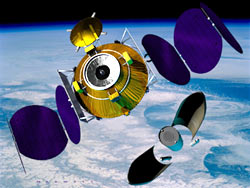Satellite hunters: "Arian Space" and "Orbital Recovery" intend to launch into space in 2007 a spacecraft-tow to return satellites to a proper orbit. It turns out that we are not the only ones who sometimes "go off the rails"
By: Yoram Ored, Galileo

Illustration from the Orbital Recovery site
Not only children and adults "go off the rails" sometimes. It turns out that satellites do this too. Many satellites orbiting the Earth for various purposes sometimes tend to deviate from their planned orbit, which can sometimes disrupt their performance, and sometimes even prevent them from fulfilling the purposes for which they were intended.
Trajectory deviations may be caused by various reasons, for example, a malfunction in the launch of the satellite or the gradual lowering of its orbit, due to the friction with the thin air in the near space, friction that causes the satellite's movement to slow down and, as a result, to lower its orbit around the Earth.
to return unruly to the track
To try to deal with the problem of deviating from orbit, two companies, 'Orbital Recovery', the initiative of the idea, and the European launch company 'Arian Spey's' joined together. They intend to launch a tug spacecraft in 2007, whose role will be to return wayward satellites to a proper orbit in space. The two companies intend to launch four more such spacecraft during 2008.
The necessity of such towed spaceships is clear from an economic point of view. Different types of satellites, such as communication satellites, weather satellites and even spy satellites, cost a lot of money. Instead of losing such satellites, it will be possible to return them to a proper orbit at a financial cost that will, it is assumed, be less than that needed to build a new satellite and launch it, since in a satellite a lot of money is invested not only in the launch itself but in other components related to it such as its design and construction.
automatic process
According to the design, the weight of such a towing spacecraft will be between 1,200 and 1,400 kilograms. The spacecraft will be equipped with a holding device that will be connected to one of its engines. The approach of the spacecraft to the target satellite and its attachment to it will be carried out automatically but under the supervision of a controller located on the surface of the earth.
After the attachment to the satellite is completed, the tow spacecraft will drag it slowly, using an ion propulsion engine (ion propulsion is a rocket propulsion based on the emission of ionized gas as the rocket propellant) until it reaches the desired position. Even after the tow spacecraft arrives together with the satellite at the desired position, it will continue to be connected to it to enable further maneuvers in the future.
A legitimate candidate - the mourner
A possible candidate for use in this space towing service is none other than the Hubble Space Telescope. One of the options raised regarding the Hubble is the use of a towing spacecraft to bring it closer to the International Space Station. The proximity of the telescope to the space station, could enable the rescue of crew members who will handle the space telescope in the future, if they fall into an emergency situation.
This proximity will allow their extraction from the space telescope and their transfer to the nearby space station. There will apparently be no shortage of customers for this future tug spacecraft. According to one estimate, there are at least 50 satellites that will need its care during the next ten to twenty years. Towing services seem to be expanding beyond the confines of Earth.
